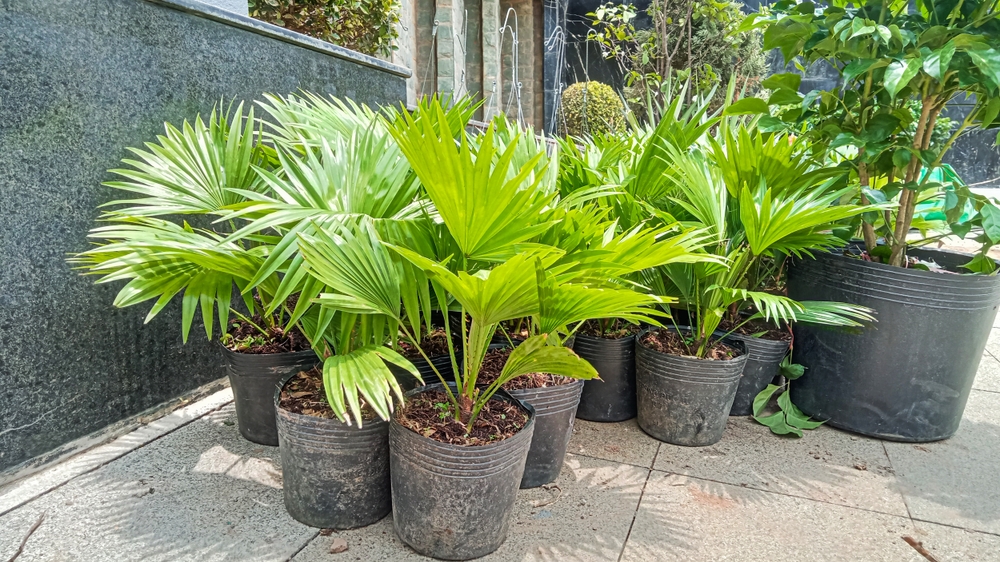The Chinese fan palm (Livistona chinensis) is a popular choice for both indoor and outdoor spaces, prized for its elegant, fan-shaped leaves and relatively easy-going nature. Native to subtropical regions of Asia, this palm brings a touch of the tropics to your home or garden. If you’re looking to add a touch of greenery with a statement plant, the Chinese fan palm is an excellent option. This comprehensive guide will provide you with all the essential information on Chinese fan palm care, ensuring your palm thrives for years to come.
Chinese Fan Palm Basics
The Chinese fan palm, scientifically known as Livistona chinensis, is a member of the Arecaceae family. This evergreen palm is characterized by its large, circular leaves that are divided into segments, resembling a folding fan. In their natural habitat, these palms can reach heights of up to 50 feet, but when grown indoors, they typically remain much smaller, making them manageable houseplants.
One of the appealing aspects of the Chinese fan palm is its adaptability. It can tolerate a range of conditions, although it certainly has preferences. With proper Chinese fan palm care, you can enjoy its lush foliage and tropical vibe, whether you live in a warm climate or want to bring a touch of the exotic indoors.
Cut Flower Care
While Chinese fan palms are not typically grown for cut flowers, the large, striking leaves can be used in floral arrangements to add a tropical touch. When incorporating fan palm leaves into bouquets, follow these tips to prolong their freshness:
- Select Healthy Leaves: Choose leaves that are vibrant green and free from blemishes or damage.
- Cut at an Angle: Use a sharp knife or floral shears to cut the stem at a 45-degree angle. This increases the surface area for water absorption.
- Hydrate Immediately: Place the cut leaves in a clean vase filled with fresh, cool water. Add floral preservative to help nourish the leaves and inhibit bacterial growth.
- Change Water Regularly: Refresh the water every one to two days to maintain hydration and prevent the buildup of bacteria.
- Mist the Leaves: Occasionally mist the leaves with water to keep them hydrated and prevent them from drying out.
- Avoid Direct Sunlight: Keep the arrangement away from direct sunlight and heat sources, which can cause the leaves to wilt prematurely.
Caring for Flowers in Gardens
Chinese fan palms are most often grown as standalone plants, either in the ground or in containers. While they don’t produce showy flowers like some other tropical plants, proper care is essential for maintaining their health and vigor.
When to Plant
The best time to plant Chinese fan palms is in the spring or early summer, allowing them ample time to establish their roots before the onset of cooler weather. In regions with mild winters, they can also be planted in the fall.
Where to Plant (Sunlight Needs)
Chinese fan palms thrive in full sun to partial shade. When planting outdoors, choose a location that receives at least six hours of direct sunlight per day. However, in hotter climates, providing some afternoon shade can prevent leaf scorch. When grown indoors, place your fan palm near a bright window that receives plenty of indirect light.
When to Water
Watering is a crucial aspect of Chinese fan palm care. These palms prefer consistently moist soil but are susceptible to root rot if overwatered. Water thoroughly when the top inch of soil feels dry to the touch, allowing excess water to drain away. Reduce watering frequency during the winter months when the plant’s growth slows down.
Common Pests and Diseases
Chinese fan palms are relatively pest-resistant, but they can occasionally be affected by scale, mealybugs, or spider mites. Regularly inspect your palm for signs of infestation and treat promptly with insecticidal soap or horticultural oil. Root rot can be a problem if the soil is poorly drained or the palm is overwatered. Ensure proper drainage and avoid overwatering to prevent this issue.
Complementary Plants
When planting Chinese fan palms in the landscape, consider companion plants that share similar growing requirements and aesthetic qualities. Some good choices include:
- Hibiscus
- Birds of Paradise
- Crotons
- Ginger Lilies
- Other tropical foliage plants
Growing Flowers in Containers
Growing Chinese fan palms in containers is a great option, especially if you live in a cooler climate where they cannot survive outdoors year-round. Container-grown palms can be easily moved indoors during the winter months and back outdoors in the spring.
When growing a Chinese fan palm in a container, choose a pot that is large enough to accommodate the root system and has drainage holes to prevent waterlogging. Use a well-draining potting mix that is rich in organic matter. Place the container in a location that receives plenty of bright, indirect light.
Compatible Types of Containers
- Terracotta Pots: These classic pots are porous, allowing for good air circulation and drainage. Their simple design complements the tropical look of the Chinese fan palm.
- Planter Boxes: Larger planter boxes are ideal for accommodating the mature size of a Chinese fan palm. They provide ample space for the roots to spread and can be easily moved with a dolly.
- Ceramic Pots: Glazed ceramic pots come in a variety of colors and styles, allowing you to customize the look of your container garden. Ensure the pot has drainage holes to prevent water from accumulating.
Don’t forget that we offer plant delivery to help get you started with your indoor garden. Also, be sure to check out our gardenia care guide for more tips. And if you’re looking for something different, consider caring for cyclamen plants.
Varieties of the Plant
While the standard Livistona chinensis is the most common variety, there are a few other cultivars worth noting:
- ‘Pendula’: This variety has slightly weeping fronds, giving it a more relaxed and graceful appearance.
- ‘Subglobosa’: This cultivar features more rounded leaves with less pronounced segments.
- Dwarf Chinese Fan Palm: A smaller, more compact variety that is ideal for growing in containers or small spaces.
Fun Facts
- The Chinese fan palm is known for its longevity and can live for many decades with proper care.
- The leaves of the Chinese fan palm have been traditionally used for thatching roofs and making hats and mats.
- This palm is a popular choice for adding a tropical touch to landscapes and interiors around the world.
Additional Tips for Thriving Chinese Fan Palms
Here are some additional tips to help you provide the best possible Chinese fan palm plant care:
- Fertilize Regularly: Feed your Chinese fan palm with a balanced palm fertilizer during the growing season (spring and summer). Follow the package instructions for application rates.
- Prune as Needed: Remove any dead, damaged, or yellowing fronds to keep your palm looking its best. Use clean, sharp pruning shears to make clean cuts.
- Provide Adequate Humidity: Chinese fan palms prefer moderate to high humidity levels. If the air in your home is dry, consider using a humidifier or misting the leaves regularly.
- Protect from Cold: While Chinese fan palms can tolerate brief periods of cold, they are not frost-hardy. Protect them from freezing temperatures by moving them indoors or providing adequate insulation.
- Repot as Necessary: As your Chinese fan palm grows, it may eventually outgrow its container. Repot it into a larger pot every few years to provide fresh soil and room for the roots to expand.
By following these Chinese fan palm care tips, you can enjoy the beauty and tropical ambiance of this elegant palm for many years to come. Remember to provide adequate sunlight, water, and nutrients, and protect it from extreme temperatures. With a little bit of attention and care, your Chinese fan palm will thrive and become a stunning focal point in your home or garden.
Shop All



